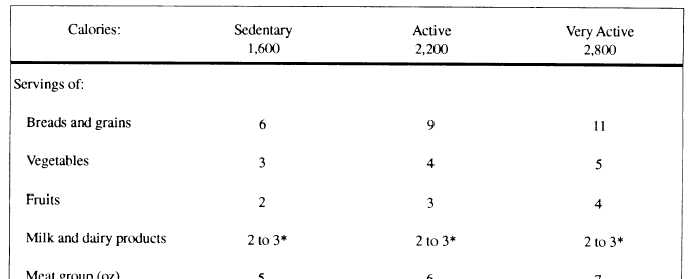| |
This pyramid (fig. 7-1) is a visual companion to the
Dietary Guidelines for Americans. The new graphic
conveys the three essential elements of a healthy diet:
proportion, moderation, and variety.
l
l
l
Proportion is the relative amount of food to
choose from each major food group.
Moderation is eating fats, oils, and sugars
sparingly.
Variety emphasizes the importance of eating a
selection of different foods from each of the
major food groups every day.
Table 7-2 illustrates the range of caloric intake and
servings needed from each major food group based on
activity level.
NOTE: The minimum suggested
servings on the pyramid are the minimum number of
servings needed each day to stay healthy, even when
trying to lose weight.
The food pyramid graphically communicates the
message of the Dietary Guidelines for Americans—
diets should be built upon a base of complex
carbohydrates and less fat. The placement of the food
groups starting at the base of the pyramid conveys the
current recommendations. These recommendations are
as follows: eat more grains, vegetables, and fruits; eat
moderate amounts of lean meats and dairy foods; and
use sweets, fats, and oils sparingly. The food guide
pyramid graphic (fig. 7-1) shows that all food groups are
important to the diet.
Grain, Cereal, Rice and Pasta Group
The food pyramid emphasizes whole grain and
cereal foods as the basis of a nutritious diet. Wheat,
corn, oats, and other grains have very little fat and are
cholesterol free.
These foods provide complex
carbohydrates—an important source of energy,
especially in low-fat diets. They also provide fiber.
A person needs 6 to 11 servings from this group
daily, depending on their activity level. You should offer
whole grain and enriched or fortified products, but be
sure to include some whole grain bread or cereals.
WHAT IS A SERVING?— It includes all products
made with whole grain or enriched flour or meal such
as bread, biscuits, muffins, waffles, pancakes, cooked or
ready-to-eat cereals, cornmeal, flour, grits, macaroni
and spaghetti, noodles, rice, rolled oats, and barley.
The following are some examples of a typical
serving from the grain group:
. 1 slice of bread
. 1/2 cup of cooked cereal, cornmeal, grits,
macaroni, noodles, rice or spaghetti
Table 7-2.—Range of Caloric Intake and Servings Needed Based on Activity Level
7-6
|


